Ingogo Taxi: Marketing Management and Digital Communication
VerifiedAdded on 2021/06/16
|13
|3119
|41
Report
AI Summary
This report provides a comprehensive strategic marketing plan for Ingogo Taxi, an Australian online taxi booking service. The report begins with an executive summary, followed by an introduction and a situation analysis, including an overview of the company, its market, and competitors like Uber and Yellow Cabs. It identifies the problem statement, highlighting the intense competition in the industry and the need for Ingogo to differentiate itself. The report then outlines potential market segments, target market positioning, marketing and financial objectives, and a detailed marketing strategy and mix, including product, price, place, and promotion strategies. The implementation and control sections discuss organizational structure, incentives, and performance appraisal systems. Finally, the report concludes with a promotion mix and budget allocation to facilitate effective market penetration and expansion, including advertising, sales promotion, public relations, and personal selling. The report aims to assist Ingogo in strengthening its brand image, expanding its market share, and achieving sustainable growth in the competitive Australian taxi market.
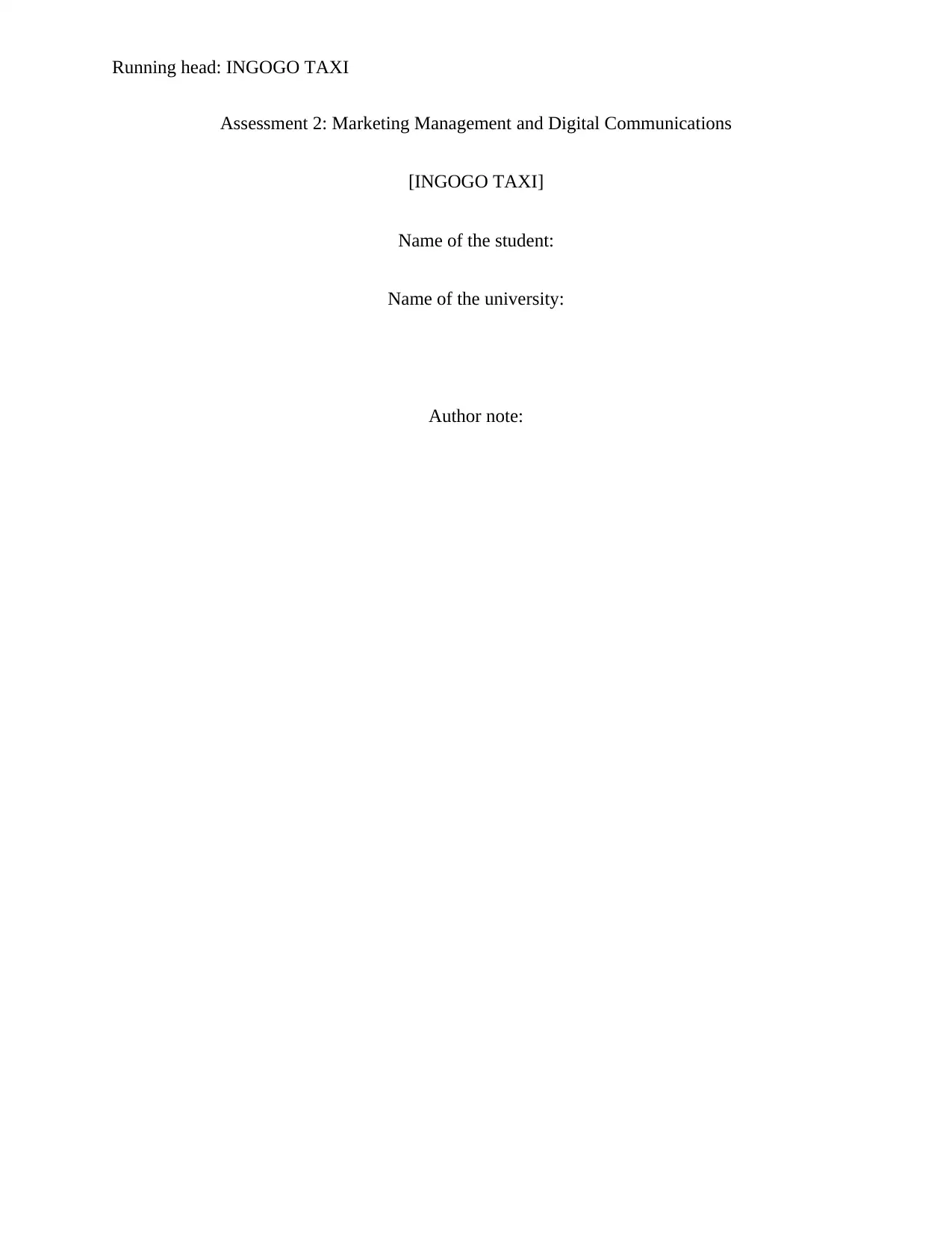
Running head: INGOGO TAXI
Assessment 2: Marketing Management and Digital Communications
[INGOGO TAXI]
Name of the student:
Name of the university:
Author note:
Assessment 2: Marketing Management and Digital Communications
[INGOGO TAXI]
Name of the student:
Name of the university:
Author note:
Paraphrase This Document
Need a fresh take? Get an instant paraphrase of this document with our AI Paraphraser
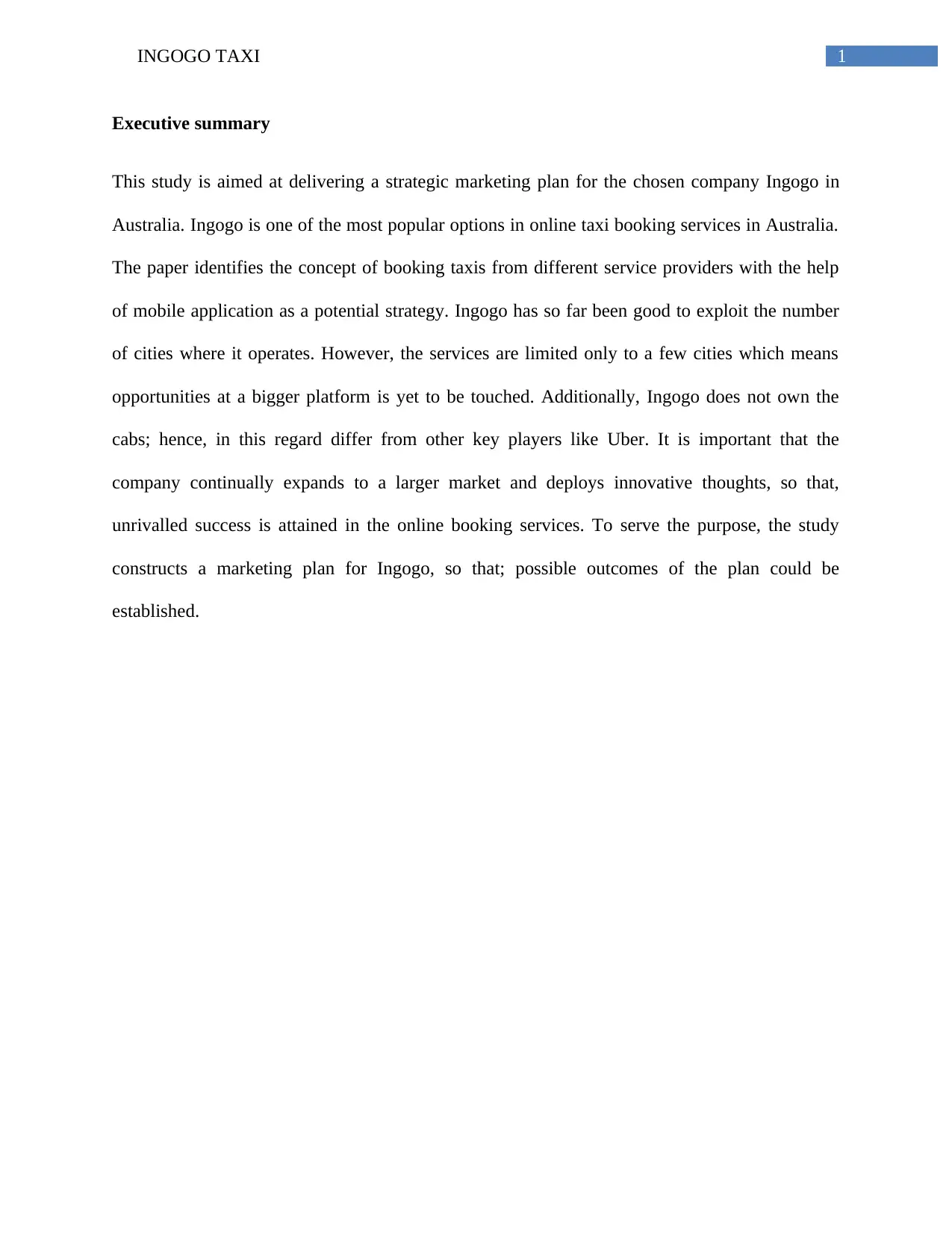
1INGOGO TAXI
Executive summary
This study is aimed at delivering a strategic marketing plan for the chosen company Ingogo in
Australia. Ingogo is one of the most popular options in online taxi booking services in Australia.
The paper identifies the concept of booking taxis from different service providers with the help
of mobile application as a potential strategy. Ingogo has so far been good to exploit the number
of cities where it operates. However, the services are limited only to a few cities which means
opportunities at a bigger platform is yet to be touched. Additionally, Ingogo does not own the
cabs; hence, in this regard differ from other key players like Uber. It is important that the
company continually expands to a larger market and deploys innovative thoughts, so that,
unrivalled success is attained in the online booking services. To serve the purpose, the study
constructs a marketing plan for Ingogo, so that; possible outcomes of the plan could be
established.
Executive summary
This study is aimed at delivering a strategic marketing plan for the chosen company Ingogo in
Australia. Ingogo is one of the most popular options in online taxi booking services in Australia.
The paper identifies the concept of booking taxis from different service providers with the help
of mobile application as a potential strategy. Ingogo has so far been good to exploit the number
of cities where it operates. However, the services are limited only to a few cities which means
opportunities at a bigger platform is yet to be touched. Additionally, Ingogo does not own the
cabs; hence, in this regard differ from other key players like Uber. It is important that the
company continually expands to a larger market and deploys innovative thoughts, so that,
unrivalled success is attained in the online booking services. To serve the purpose, the study
constructs a marketing plan for Ingogo, so that; possible outcomes of the plan could be
established.
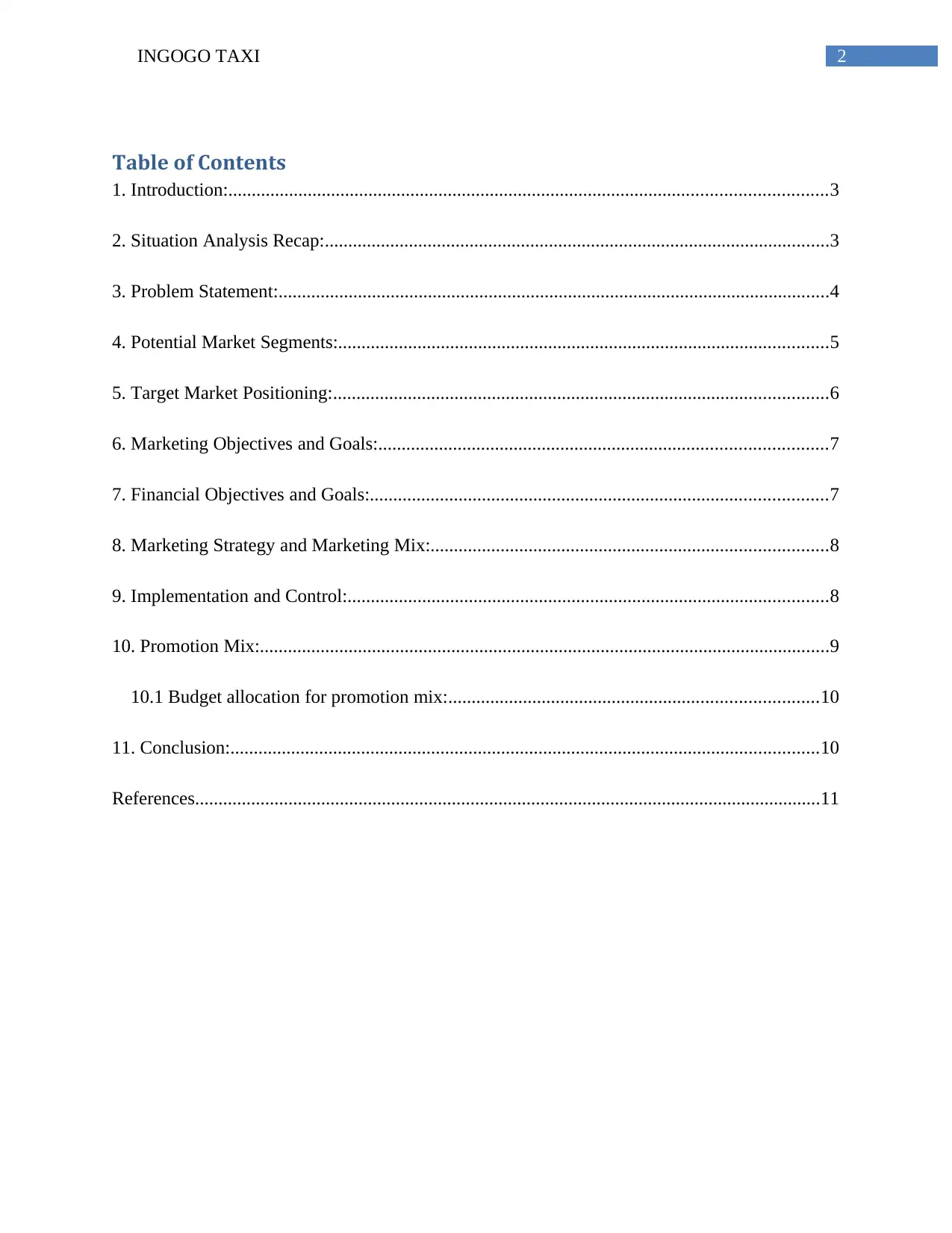
2INGOGO TAXI
Table of Contents
1. Introduction:................................................................................................................................3
2. Situation Analysis Recap:............................................................................................................3
3. Problem Statement:......................................................................................................................4
4. Potential Market Segments:.........................................................................................................5
5. Target Market Positioning:..........................................................................................................6
6. Marketing Objectives and Goals:................................................................................................7
7. Financial Objectives and Goals:..................................................................................................7
8. Marketing Strategy and Marketing Mix:.....................................................................................8
9. Implementation and Control:.......................................................................................................8
10. Promotion Mix:..........................................................................................................................9
10.1 Budget allocation for promotion mix:...............................................................................10
11. Conclusion:..............................................................................................................................10
References......................................................................................................................................11
Table of Contents
1. Introduction:................................................................................................................................3
2. Situation Analysis Recap:............................................................................................................3
3. Problem Statement:......................................................................................................................4
4. Potential Market Segments:.........................................................................................................5
5. Target Market Positioning:..........................................................................................................6
6. Marketing Objectives and Goals:................................................................................................7
7. Financial Objectives and Goals:..................................................................................................7
8. Marketing Strategy and Marketing Mix:.....................................................................................8
9. Implementation and Control:.......................................................................................................8
10. Promotion Mix:..........................................................................................................................9
10.1 Budget allocation for promotion mix:...............................................................................10
11. Conclusion:..............................................................................................................................10
References......................................................................................................................................11
⊘ This is a preview!⊘
Do you want full access?
Subscribe today to unlock all pages.

Trusted by 1+ million students worldwide
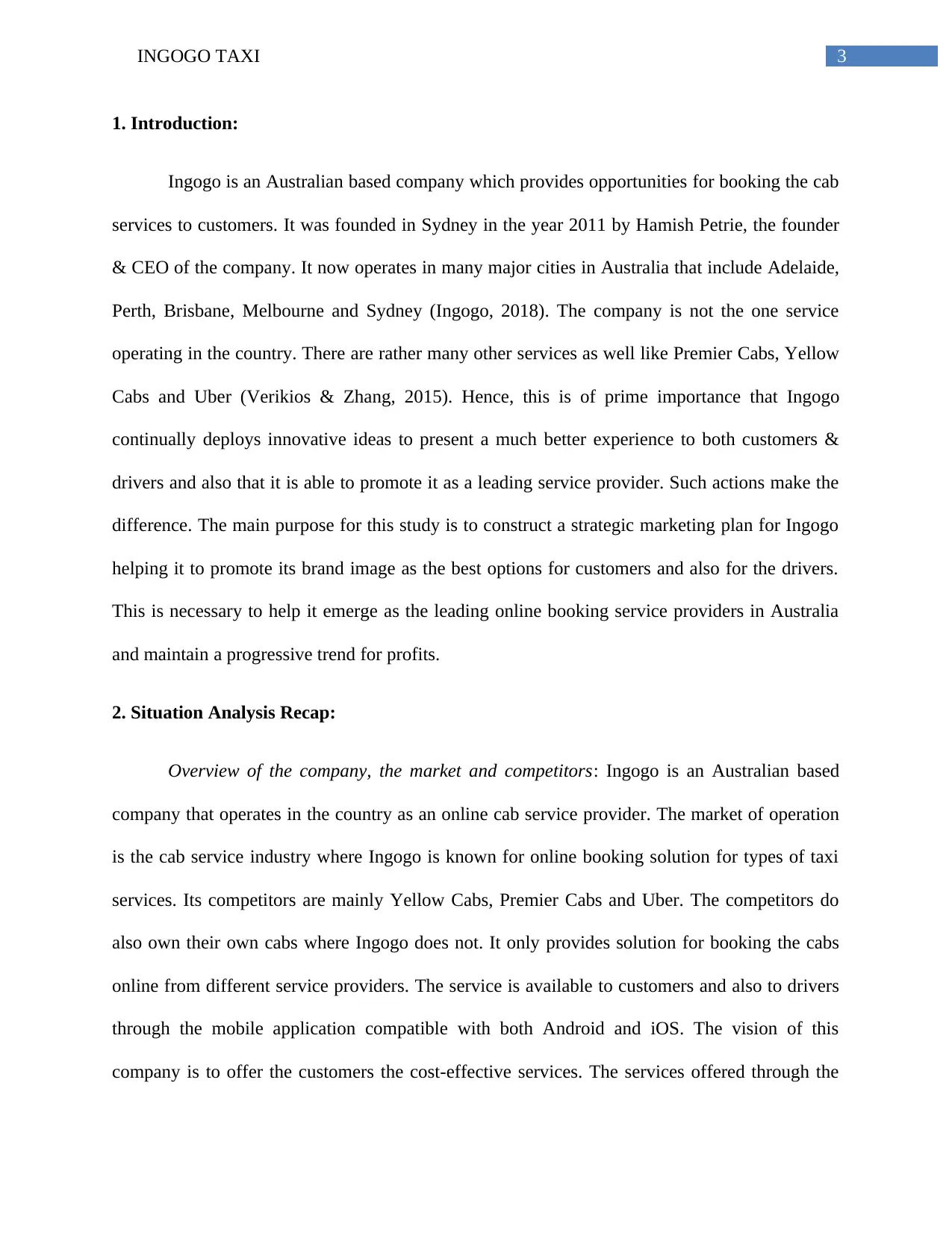
3INGOGO TAXI
1. Introduction:
Ingogo is an Australian based company which provides opportunities for booking the cab
services to customers. It was founded in Sydney in the year 2011 by Hamish Petrie, the founder
& CEO of the company. It now operates in many major cities in Australia that include Adelaide,
Perth, Brisbane, Melbourne and Sydney (Ingogo, 2018). The company is not the one service
operating in the country. There are rather many other services as well like Premier Cabs, Yellow
Cabs and Uber (Verikios & Zhang, 2015). Hence, this is of prime importance that Ingogo
continually deploys innovative ideas to present a much better experience to both customers &
drivers and also that it is able to promote it as a leading service provider. Such actions make the
difference. The main purpose for this study is to construct a strategic marketing plan for Ingogo
helping it to promote its brand image as the best options for customers and also for the drivers.
This is necessary to help it emerge as the leading online booking service providers in Australia
and maintain a progressive trend for profits.
2. Situation Analysis Recap:
Overview of the company, the market and competitors: Ingogo is an Australian based
company that operates in the country as an online cab service provider. The market of operation
is the cab service industry where Ingogo is known for online booking solution for types of taxi
services. Its competitors are mainly Yellow Cabs, Premier Cabs and Uber. The competitors do
also own their own cabs where Ingogo does not. It only provides solution for booking the cabs
online from different service providers. The service is available to customers and also to drivers
through the mobile application compatible with both Android and iOS. The vision of this
company is to offer the customers the cost-effective services. The services offered through the
1. Introduction:
Ingogo is an Australian based company which provides opportunities for booking the cab
services to customers. It was founded in Sydney in the year 2011 by Hamish Petrie, the founder
& CEO of the company. It now operates in many major cities in Australia that include Adelaide,
Perth, Brisbane, Melbourne and Sydney (Ingogo, 2018). The company is not the one service
operating in the country. There are rather many other services as well like Premier Cabs, Yellow
Cabs and Uber (Verikios & Zhang, 2015). Hence, this is of prime importance that Ingogo
continually deploys innovative ideas to present a much better experience to both customers &
drivers and also that it is able to promote it as a leading service provider. Such actions make the
difference. The main purpose for this study is to construct a strategic marketing plan for Ingogo
helping it to promote its brand image as the best options for customers and also for the drivers.
This is necessary to help it emerge as the leading online booking service providers in Australia
and maintain a progressive trend for profits.
2. Situation Analysis Recap:
Overview of the company, the market and competitors: Ingogo is an Australian based
company that operates in the country as an online cab service provider. The market of operation
is the cab service industry where Ingogo is known for online booking solution for types of taxi
services. Its competitors are mainly Yellow Cabs, Premier Cabs and Uber. The competitors do
also own their own cabs where Ingogo does not. It only provides solution for booking the cabs
online from different service providers. The service is available to customers and also to drivers
through the mobile application compatible with both Android and iOS. The vision of this
company is to offer the customers the cost-effective services. The services offered through the
Paraphrase This Document
Need a fresh take? Get an instant paraphrase of this document with our AI Paraphraser
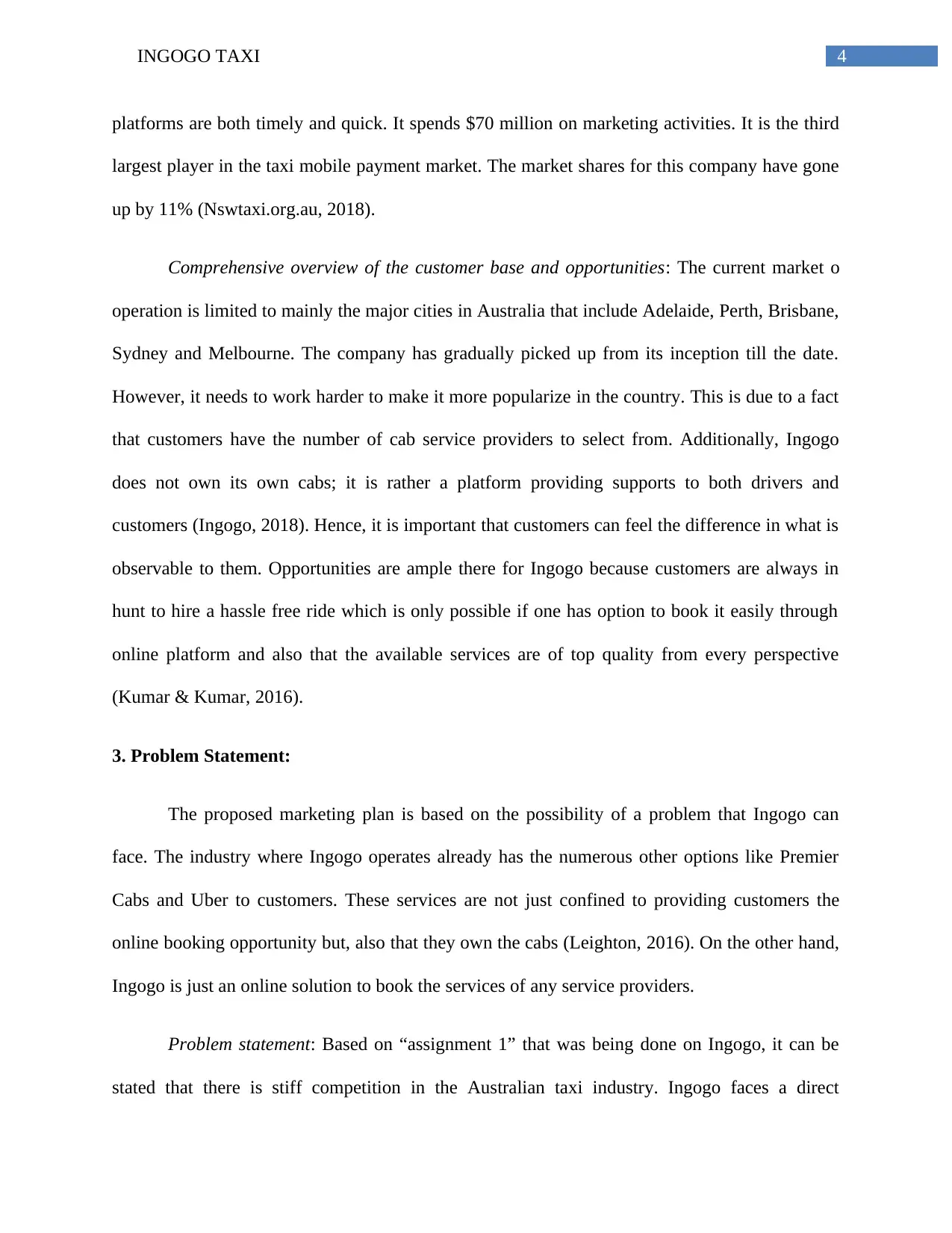
4INGOGO TAXI
platforms are both timely and quick. It spends $70 million on marketing activities. It is the third
largest player in the taxi mobile payment market. The market shares for this company have gone
up by 11% (Nswtaxi.org.au, 2018).
Comprehensive overview of the customer base and opportunities: The current market o
operation is limited to mainly the major cities in Australia that include Adelaide, Perth, Brisbane,
Sydney and Melbourne. The company has gradually picked up from its inception till the date.
However, it needs to work harder to make it more popularize in the country. This is due to a fact
that customers have the number of cab service providers to select from. Additionally, Ingogo
does not own its own cabs; it is rather a platform providing supports to both drivers and
customers (Ingogo, 2018). Hence, it is important that customers can feel the difference in what is
observable to them. Opportunities are ample there for Ingogo because customers are always in
hunt to hire a hassle free ride which is only possible if one has option to book it easily through
online platform and also that the available services are of top quality from every perspective
(Kumar & Kumar, 2016).
3. Problem Statement:
The proposed marketing plan is based on the possibility of a problem that Ingogo can
face. The industry where Ingogo operates already has the numerous other options like Premier
Cabs and Uber to customers. These services are not just confined to providing customers the
online booking opportunity but, also that they own the cabs (Leighton, 2016). On the other hand,
Ingogo is just an online solution to book the services of any service providers.
Problem statement: Based on “assignment 1” that was being done on Ingogo, it can be
stated that there is stiff competition in the Australian taxi industry. Ingogo faces a direct
platforms are both timely and quick. It spends $70 million on marketing activities. It is the third
largest player in the taxi mobile payment market. The market shares for this company have gone
up by 11% (Nswtaxi.org.au, 2018).
Comprehensive overview of the customer base and opportunities: The current market o
operation is limited to mainly the major cities in Australia that include Adelaide, Perth, Brisbane,
Sydney and Melbourne. The company has gradually picked up from its inception till the date.
However, it needs to work harder to make it more popularize in the country. This is due to a fact
that customers have the number of cab service providers to select from. Additionally, Ingogo
does not own its own cabs; it is rather a platform providing supports to both drivers and
customers (Ingogo, 2018). Hence, it is important that customers can feel the difference in what is
observable to them. Opportunities are ample there for Ingogo because customers are always in
hunt to hire a hassle free ride which is only possible if one has option to book it easily through
online platform and also that the available services are of top quality from every perspective
(Kumar & Kumar, 2016).
3. Problem Statement:
The proposed marketing plan is based on the possibility of a problem that Ingogo can
face. The industry where Ingogo operates already has the numerous other options like Premier
Cabs and Uber to customers. These services are not just confined to providing customers the
online booking opportunity but, also that they own the cabs (Leighton, 2016). On the other hand,
Ingogo is just an online solution to book the services of any service providers.
Problem statement: Based on “assignment 1” that was being done on Ingogo, it can be
stated that there is stiff competition in the Australian taxi industry. Ingogo faces a direct
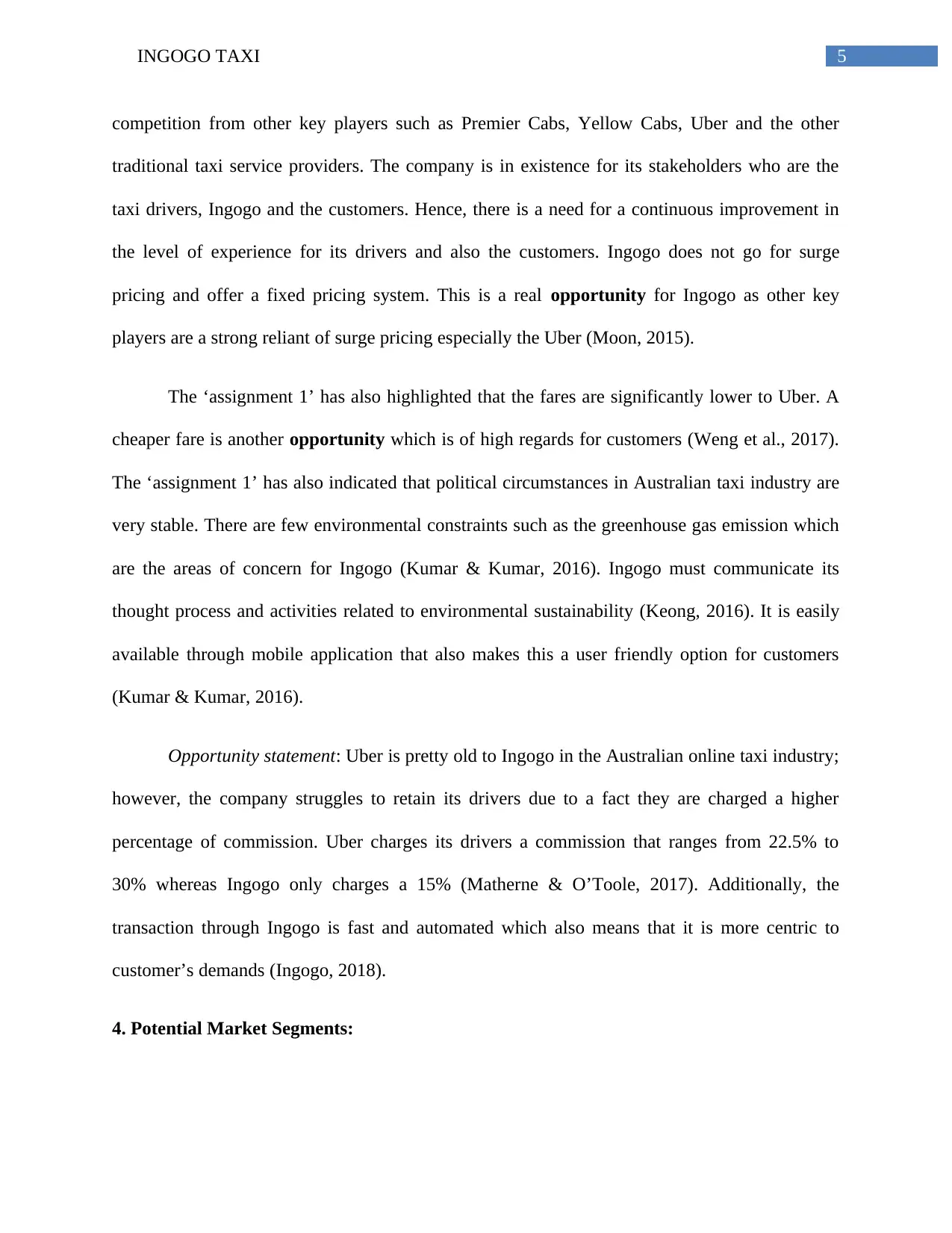
5INGOGO TAXI
competition from other key players such as Premier Cabs, Yellow Cabs, Uber and the other
traditional taxi service providers. The company is in existence for its stakeholders who are the
taxi drivers, Ingogo and the customers. Hence, there is a need for a continuous improvement in
the level of experience for its drivers and also the customers. Ingogo does not go for surge
pricing and offer a fixed pricing system. This is a real opportunity for Ingogo as other key
players are a strong reliant of surge pricing especially the Uber (Moon, 2015).
The ‘assignment 1’ has also highlighted that the fares are significantly lower to Uber. A
cheaper fare is another opportunity which is of high regards for customers (Weng et al., 2017).
The ‘assignment 1’ has also indicated that political circumstances in Australian taxi industry are
very stable. There are few environmental constraints such as the greenhouse gas emission which
are the areas of concern for Ingogo (Kumar & Kumar, 2016). Ingogo must communicate its
thought process and activities related to environmental sustainability (Keong, 2016). It is easily
available through mobile application that also makes this a user friendly option for customers
(Kumar & Kumar, 2016).
Opportunity statement: Uber is pretty old to Ingogo in the Australian online taxi industry;
however, the company struggles to retain its drivers due to a fact they are charged a higher
percentage of commission. Uber charges its drivers a commission that ranges from 22.5% to
30% whereas Ingogo only charges a 15% (Matherne & O’Toole, 2017). Additionally, the
transaction through Ingogo is fast and automated which also means that it is more centric to
customer’s demands (Ingogo, 2018).
4. Potential Market Segments:
competition from other key players such as Premier Cabs, Yellow Cabs, Uber and the other
traditional taxi service providers. The company is in existence for its stakeholders who are the
taxi drivers, Ingogo and the customers. Hence, there is a need for a continuous improvement in
the level of experience for its drivers and also the customers. Ingogo does not go for surge
pricing and offer a fixed pricing system. This is a real opportunity for Ingogo as other key
players are a strong reliant of surge pricing especially the Uber (Moon, 2015).
The ‘assignment 1’ has also highlighted that the fares are significantly lower to Uber. A
cheaper fare is another opportunity which is of high regards for customers (Weng et al., 2017).
The ‘assignment 1’ has also indicated that political circumstances in Australian taxi industry are
very stable. There are few environmental constraints such as the greenhouse gas emission which
are the areas of concern for Ingogo (Kumar & Kumar, 2016). Ingogo must communicate its
thought process and activities related to environmental sustainability (Keong, 2016). It is easily
available through mobile application that also makes this a user friendly option for customers
(Kumar & Kumar, 2016).
Opportunity statement: Uber is pretty old to Ingogo in the Australian online taxi industry;
however, the company struggles to retain its drivers due to a fact they are charged a higher
percentage of commission. Uber charges its drivers a commission that ranges from 22.5% to
30% whereas Ingogo only charges a 15% (Matherne & O’Toole, 2017). Additionally, the
transaction through Ingogo is fast and automated which also means that it is more centric to
customer’s demands (Ingogo, 2018).
4. Potential Market Segments:
⊘ This is a preview!⊘
Do you want full access?
Subscribe today to unlock all pages.

Trusted by 1+ million students worldwide
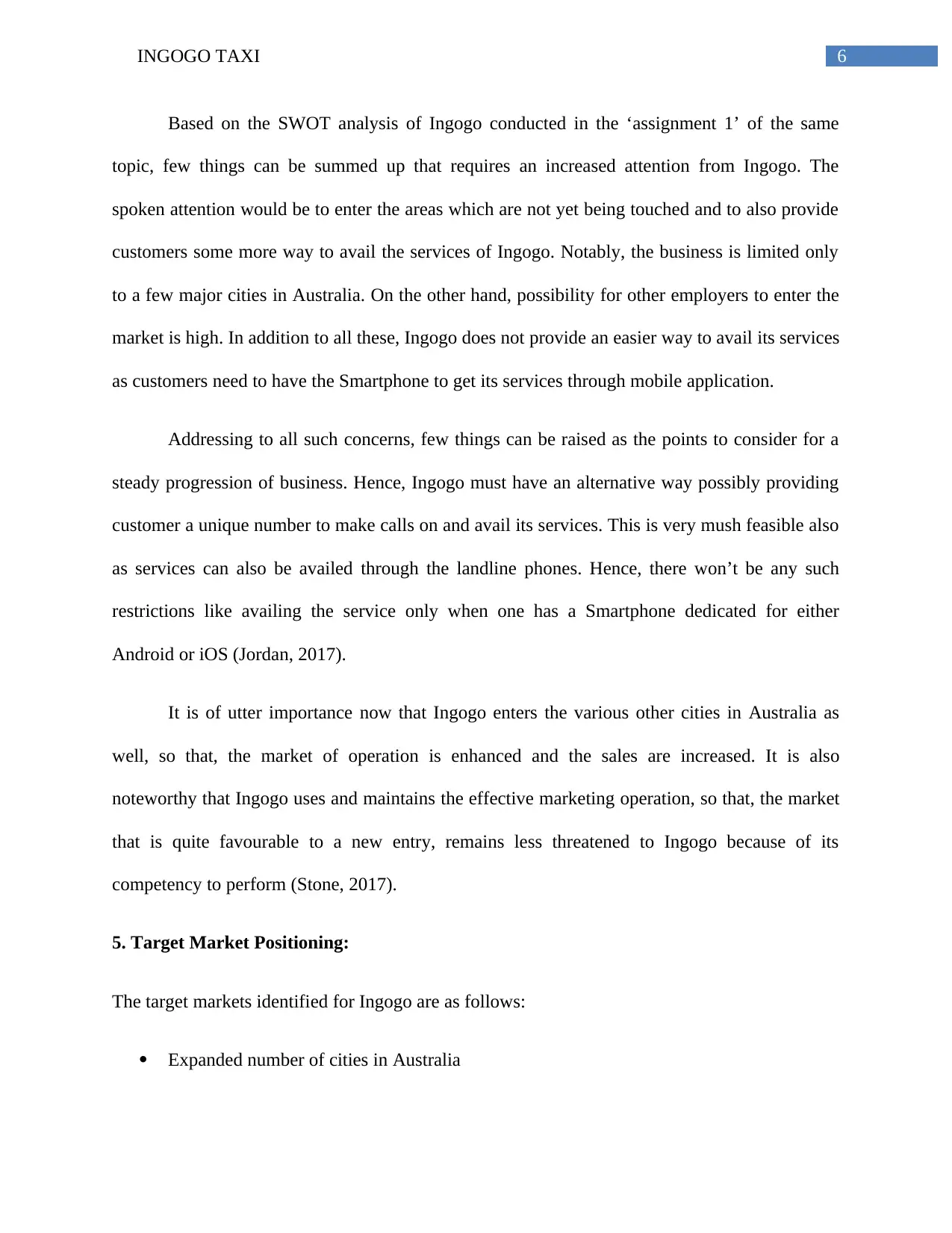
6INGOGO TAXI
Based on the SWOT analysis of Ingogo conducted in the ‘assignment 1’ of the same
topic, few things can be summed up that requires an increased attention from Ingogo. The
spoken attention would be to enter the areas which are not yet being touched and to also provide
customers some more way to avail the services of Ingogo. Notably, the business is limited only
to a few major cities in Australia. On the other hand, possibility for other employers to enter the
market is high. In addition to all these, Ingogo does not provide an easier way to avail its services
as customers need to have the Smartphone to get its services through mobile application.
Addressing to all such concerns, few things can be raised as the points to consider for a
steady progression of business. Hence, Ingogo must have an alternative way possibly providing
customer a unique number to make calls on and avail its services. This is very mush feasible also
as services can also be availed through the landline phones. Hence, there won’t be any such
restrictions like availing the service only when one has a Smartphone dedicated for either
Android or iOS (Jordan, 2017).
It is of utter importance now that Ingogo enters the various other cities in Australia as
well, so that, the market of operation is enhanced and the sales are increased. It is also
noteworthy that Ingogo uses and maintains the effective marketing operation, so that, the market
that is quite favourable to a new entry, remains less threatened to Ingogo because of its
competency to perform (Stone, 2017).
5. Target Market Positioning:
The target markets identified for Ingogo are as follows:
Expanded number of cities in Australia
Based on the SWOT analysis of Ingogo conducted in the ‘assignment 1’ of the same
topic, few things can be summed up that requires an increased attention from Ingogo. The
spoken attention would be to enter the areas which are not yet being touched and to also provide
customers some more way to avail the services of Ingogo. Notably, the business is limited only
to a few major cities in Australia. On the other hand, possibility for other employers to enter the
market is high. In addition to all these, Ingogo does not provide an easier way to avail its services
as customers need to have the Smartphone to get its services through mobile application.
Addressing to all such concerns, few things can be raised as the points to consider for a
steady progression of business. Hence, Ingogo must have an alternative way possibly providing
customer a unique number to make calls on and avail its services. This is very mush feasible also
as services can also be availed through the landline phones. Hence, there won’t be any such
restrictions like availing the service only when one has a Smartphone dedicated for either
Android or iOS (Jordan, 2017).
It is of utter importance now that Ingogo enters the various other cities in Australia as
well, so that, the market of operation is enhanced and the sales are increased. It is also
noteworthy that Ingogo uses and maintains the effective marketing operation, so that, the market
that is quite favourable to a new entry, remains less threatened to Ingogo because of its
competency to perform (Stone, 2017).
5. Target Market Positioning:
The target markets identified for Ingogo are as follows:
Expanded number of cities in Australia
Paraphrase This Document
Need a fresh take? Get an instant paraphrase of this document with our AI Paraphraser
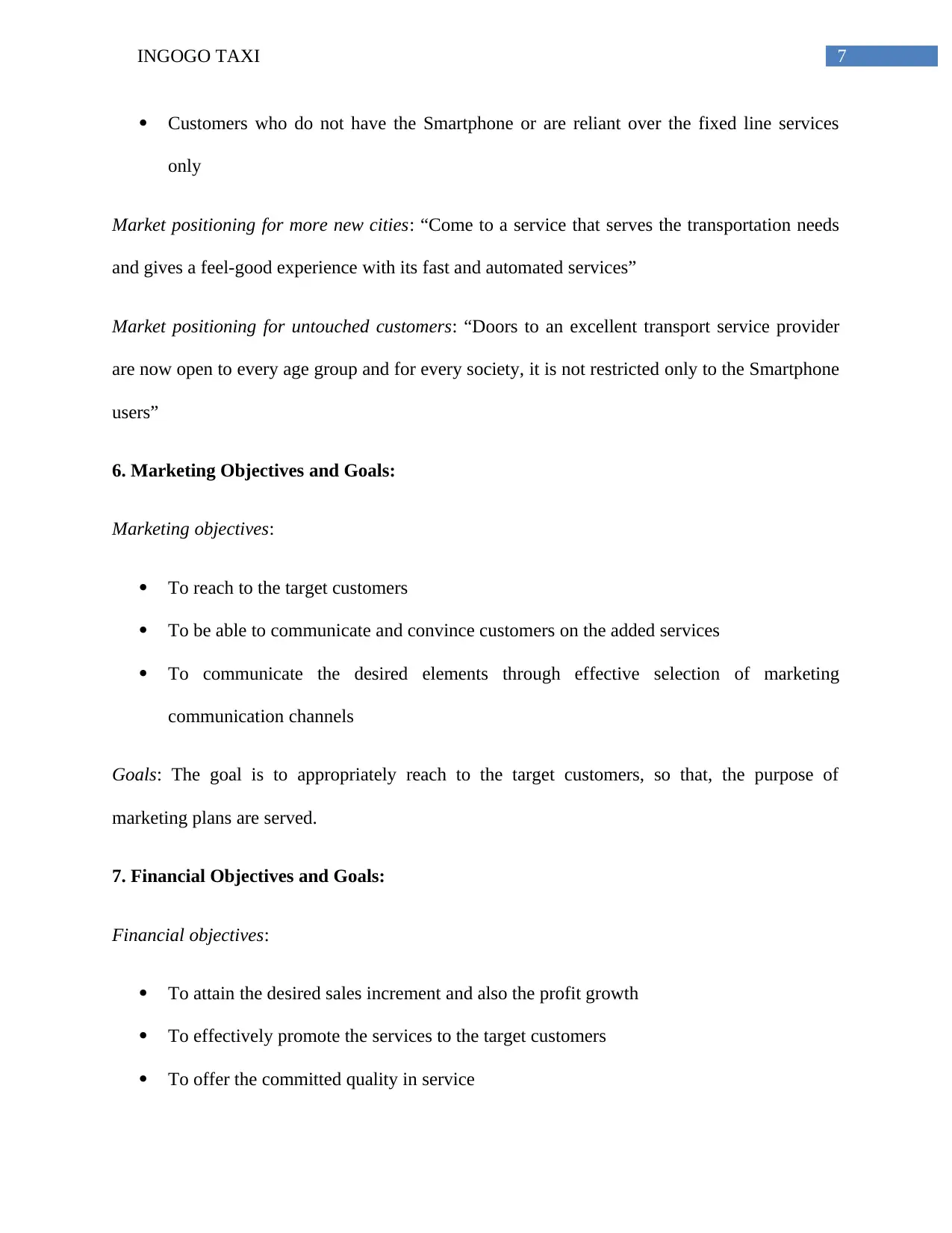
7INGOGO TAXI
Customers who do not have the Smartphone or are reliant over the fixed line services
only
Market positioning for more new cities: “Come to a service that serves the transportation needs
and gives a feel-good experience with its fast and automated services”
Market positioning for untouched customers: “Doors to an excellent transport service provider
are now open to every age group and for every society, it is not restricted only to the Smartphone
users”
6. Marketing Objectives and Goals:
Marketing objectives:
To reach to the target customers
To be able to communicate and convince customers on the added services
To communicate the desired elements through effective selection of marketing
communication channels
Goals: The goal is to appropriately reach to the target customers, so that, the purpose of
marketing plans are served.
7. Financial Objectives and Goals:
Financial objectives:
To attain the desired sales increment and also the profit growth
To effectively promote the services to the target customers
To offer the committed quality in service
Customers who do not have the Smartphone or are reliant over the fixed line services
only
Market positioning for more new cities: “Come to a service that serves the transportation needs
and gives a feel-good experience with its fast and automated services”
Market positioning for untouched customers: “Doors to an excellent transport service provider
are now open to every age group and for every society, it is not restricted only to the Smartphone
users”
6. Marketing Objectives and Goals:
Marketing objectives:
To reach to the target customers
To be able to communicate and convince customers on the added services
To communicate the desired elements through effective selection of marketing
communication channels
Goals: The goal is to appropriately reach to the target customers, so that, the purpose of
marketing plans are served.
7. Financial Objectives and Goals:
Financial objectives:
To attain the desired sales increment and also the profit growth
To effectively promote the services to the target customers
To offer the committed quality in service
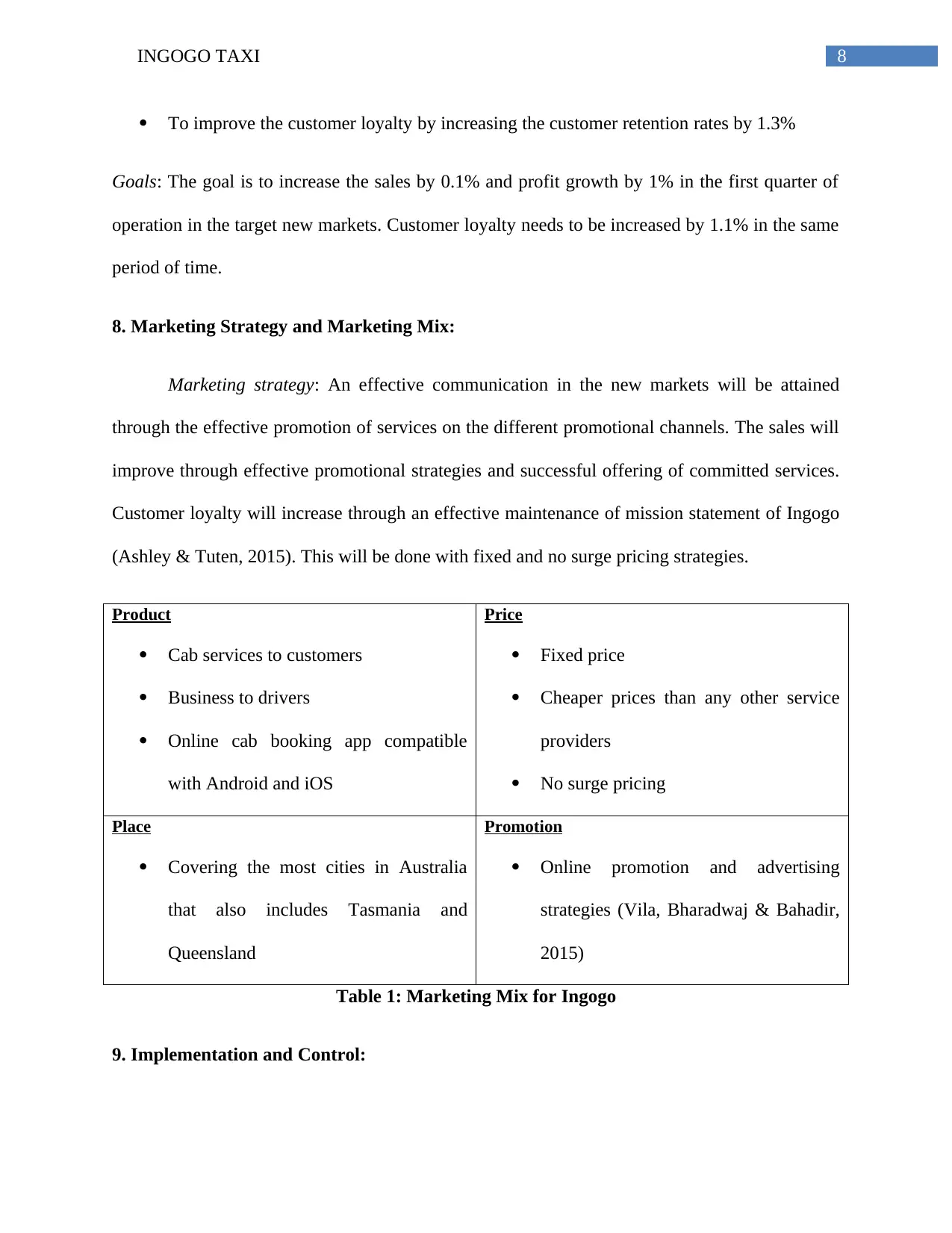
8INGOGO TAXI
To improve the customer loyalty by increasing the customer retention rates by 1.3%
Goals: The goal is to increase the sales by 0.1% and profit growth by 1% in the first quarter of
operation in the target new markets. Customer loyalty needs to be increased by 1.1% in the same
period of time.
8. Marketing Strategy and Marketing Mix:
Marketing strategy: An effective communication in the new markets will be attained
through the effective promotion of services on the different promotional channels. The sales will
improve through effective promotional strategies and successful offering of committed services.
Customer loyalty will increase through an effective maintenance of mission statement of Ingogo
(Ashley & Tuten, 2015). This will be done with fixed and no surge pricing strategies.
Product
Cab services to customers
Business to drivers
Online cab booking app compatible
with Android and iOS
Price
Fixed price
Cheaper prices than any other service
providers
No surge pricing
Place
Covering the most cities in Australia
that also includes Tasmania and
Queensland
Promotion
Online promotion and advertising
strategies (Vila, Bharadwaj & Bahadir,
2015)
Table 1: Marketing Mix for Ingogo
9. Implementation and Control:
To improve the customer loyalty by increasing the customer retention rates by 1.3%
Goals: The goal is to increase the sales by 0.1% and profit growth by 1% in the first quarter of
operation in the target new markets. Customer loyalty needs to be increased by 1.1% in the same
period of time.
8. Marketing Strategy and Marketing Mix:
Marketing strategy: An effective communication in the new markets will be attained
through the effective promotion of services on the different promotional channels. The sales will
improve through effective promotional strategies and successful offering of committed services.
Customer loyalty will increase through an effective maintenance of mission statement of Ingogo
(Ashley & Tuten, 2015). This will be done with fixed and no surge pricing strategies.
Product
Cab services to customers
Business to drivers
Online cab booking app compatible
with Android and iOS
Price
Fixed price
Cheaper prices than any other service
providers
No surge pricing
Place
Covering the most cities in Australia
that also includes Tasmania and
Queensland
Promotion
Online promotion and advertising
strategies (Vila, Bharadwaj & Bahadir,
2015)
Table 1: Marketing Mix for Ingogo
9. Implementation and Control:
⊘ This is a preview!⊘
Do you want full access?
Subscribe today to unlock all pages.

Trusted by 1+ million students worldwide
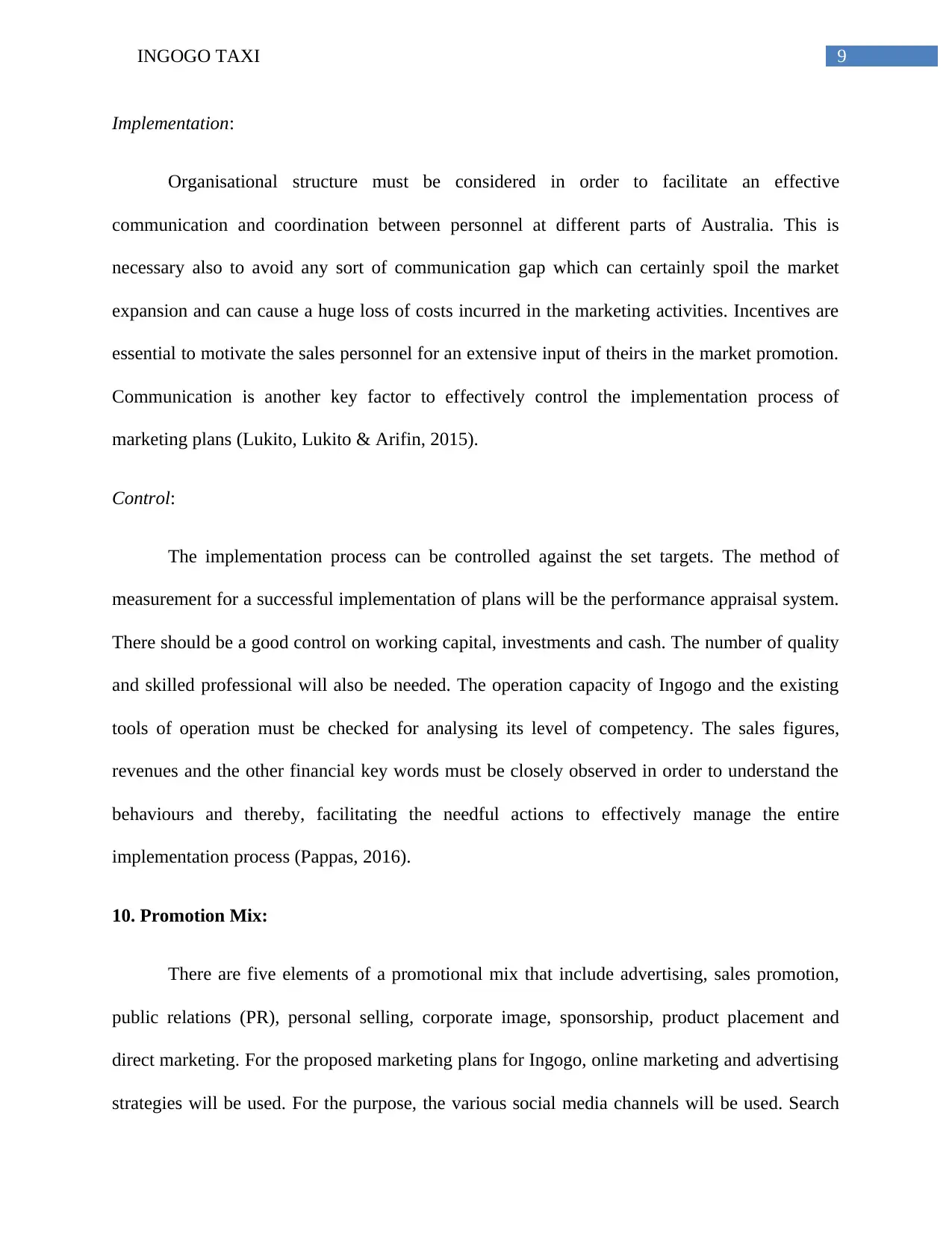
9INGOGO TAXI
Implementation:
Organisational structure must be considered in order to facilitate an effective
communication and coordination between personnel at different parts of Australia. This is
necessary also to avoid any sort of communication gap which can certainly spoil the market
expansion and can cause a huge loss of costs incurred in the marketing activities. Incentives are
essential to motivate the sales personnel for an extensive input of theirs in the market promotion.
Communication is another key factor to effectively control the implementation process of
marketing plans (Lukito, Lukito & Arifin, 2015).
Control:
The implementation process can be controlled against the set targets. The method of
measurement for a successful implementation of plans will be the performance appraisal system.
There should be a good control on working capital, investments and cash. The number of quality
and skilled professional will also be needed. The operation capacity of Ingogo and the existing
tools of operation must be checked for analysing its level of competency. The sales figures,
revenues and the other financial key words must be closely observed in order to understand the
behaviours and thereby, facilitating the needful actions to effectively manage the entire
implementation process (Pappas, 2016).
10. Promotion Mix:
There are five elements of a promotional mix that include advertising, sales promotion,
public relations (PR), personal selling, corporate image, sponsorship, product placement and
direct marketing. For the proposed marketing plans for Ingogo, online marketing and advertising
strategies will be used. For the purpose, the various social media channels will be used. Search
Implementation:
Organisational structure must be considered in order to facilitate an effective
communication and coordination between personnel at different parts of Australia. This is
necessary also to avoid any sort of communication gap which can certainly spoil the market
expansion and can cause a huge loss of costs incurred in the marketing activities. Incentives are
essential to motivate the sales personnel for an extensive input of theirs in the market promotion.
Communication is another key factor to effectively control the implementation process of
marketing plans (Lukito, Lukito & Arifin, 2015).
Control:
The implementation process can be controlled against the set targets. The method of
measurement for a successful implementation of plans will be the performance appraisal system.
There should be a good control on working capital, investments and cash. The number of quality
and skilled professional will also be needed. The operation capacity of Ingogo and the existing
tools of operation must be checked for analysing its level of competency. The sales figures,
revenues and the other financial key words must be closely observed in order to understand the
behaviours and thereby, facilitating the needful actions to effectively manage the entire
implementation process (Pappas, 2016).
10. Promotion Mix:
There are five elements of a promotional mix that include advertising, sales promotion,
public relations (PR), personal selling, corporate image, sponsorship, product placement and
direct marketing. For the proposed marketing plans for Ingogo, online marketing and advertising
strategies will be used. For the purpose, the various social media channels will be used. Search
Paraphrase This Document
Need a fresh take? Get an instant paraphrase of this document with our AI Paraphraser
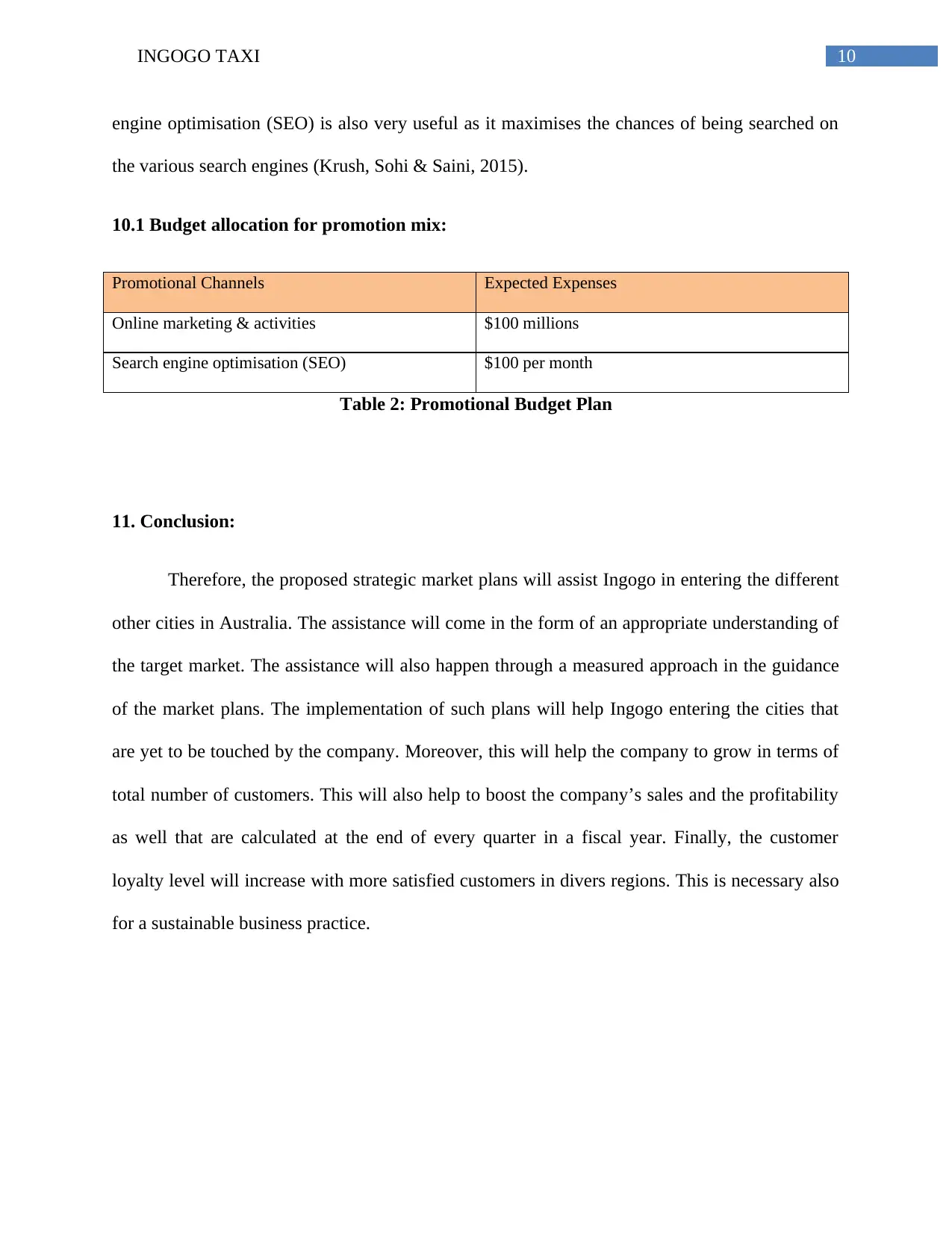
10INGOGO TAXI
engine optimisation (SEO) is also very useful as it maximises the chances of being searched on
the various search engines (Krush, Sohi & Saini, 2015).
10.1 Budget allocation for promotion mix:
Promotional Channels Expected Expenses
Online marketing & activities $100 millions
Search engine optimisation (SEO) $100 per month
Table 2: Promotional Budget Plan
11. Conclusion:
Therefore, the proposed strategic market plans will assist Ingogo in entering the different
other cities in Australia. The assistance will come in the form of an appropriate understanding of
the target market. The assistance will also happen through a measured approach in the guidance
of the market plans. The implementation of such plans will help Ingogo entering the cities that
are yet to be touched by the company. Moreover, this will help the company to grow in terms of
total number of customers. This will also help to boost the company’s sales and the profitability
as well that are calculated at the end of every quarter in a fiscal year. Finally, the customer
loyalty level will increase with more satisfied customers in divers regions. This is necessary also
for a sustainable business practice.
engine optimisation (SEO) is also very useful as it maximises the chances of being searched on
the various search engines (Krush, Sohi & Saini, 2015).
10.1 Budget allocation for promotion mix:
Promotional Channels Expected Expenses
Online marketing & activities $100 millions
Search engine optimisation (SEO) $100 per month
Table 2: Promotional Budget Plan
11. Conclusion:
Therefore, the proposed strategic market plans will assist Ingogo in entering the different
other cities in Australia. The assistance will come in the form of an appropriate understanding of
the target market. The assistance will also happen through a measured approach in the guidance
of the market plans. The implementation of such plans will help Ingogo entering the cities that
are yet to be touched by the company. Moreover, this will help the company to grow in terms of
total number of customers. This will also help to boost the company’s sales and the profitability
as well that are calculated at the end of every quarter in a fiscal year. Finally, the customer
loyalty level will increase with more satisfied customers in divers regions. This is necessary also
for a sustainable business practice.
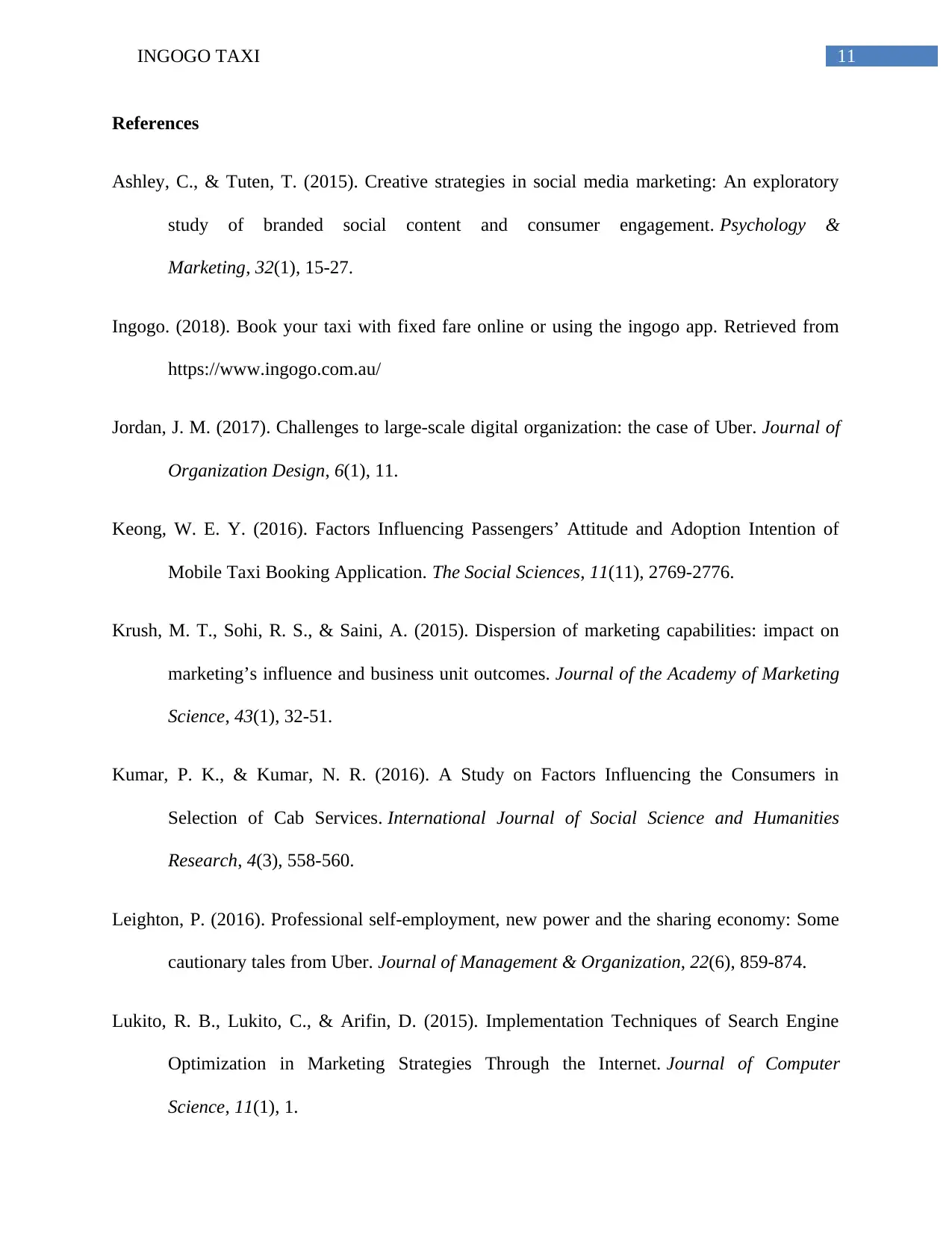
11INGOGO TAXI
References
Ashley, C., & Tuten, T. (2015). Creative strategies in social media marketing: An exploratory
study of branded social content and consumer engagement. Psychology &
Marketing, 32(1), 15-27.
Ingogo. (2018). Book your taxi with fixed fare online or using the ingogo app. Retrieved from
https://www.ingogo.com.au/
Jordan, J. M. (2017). Challenges to large-scale digital organization: the case of Uber. Journal of
Organization Design, 6(1), 11.
Keong, W. E. Y. (2016). Factors Influencing Passengers’ Attitude and Adoption Intention of
Mobile Taxi Booking Application. The Social Sciences, 11(11), 2769-2776.
Krush, M. T., Sohi, R. S., & Saini, A. (2015). Dispersion of marketing capabilities: impact on
marketing’s influence and business unit outcomes. Journal of the Academy of Marketing
Science, 43(1), 32-51.
Kumar, P. K., & Kumar, N. R. (2016). A Study on Factors Influencing the Consumers in
Selection of Cab Services. International Journal of Social Science and Humanities
Research, 4(3), 558-560.
Leighton, P. (2016). Professional self-employment, new power and the sharing economy: Some
cautionary tales from Uber. Journal of Management & Organization, 22(6), 859-874.
Lukito, R. B., Lukito, C., & Arifin, D. (2015). Implementation Techniques of Search Engine
Optimization in Marketing Strategies Through the Internet. Journal of Computer
Science, 11(1), 1.
References
Ashley, C., & Tuten, T. (2015). Creative strategies in social media marketing: An exploratory
study of branded social content and consumer engagement. Psychology &
Marketing, 32(1), 15-27.
Ingogo. (2018). Book your taxi with fixed fare online or using the ingogo app. Retrieved from
https://www.ingogo.com.au/
Jordan, J. M. (2017). Challenges to large-scale digital organization: the case of Uber. Journal of
Organization Design, 6(1), 11.
Keong, W. E. Y. (2016). Factors Influencing Passengers’ Attitude and Adoption Intention of
Mobile Taxi Booking Application. The Social Sciences, 11(11), 2769-2776.
Krush, M. T., Sohi, R. S., & Saini, A. (2015). Dispersion of marketing capabilities: impact on
marketing’s influence and business unit outcomes. Journal of the Academy of Marketing
Science, 43(1), 32-51.
Kumar, P. K., & Kumar, N. R. (2016). A Study on Factors Influencing the Consumers in
Selection of Cab Services. International Journal of Social Science and Humanities
Research, 4(3), 558-560.
Leighton, P. (2016). Professional self-employment, new power and the sharing economy: Some
cautionary tales from Uber. Journal of Management & Organization, 22(6), 859-874.
Lukito, R. B., Lukito, C., & Arifin, D. (2015). Implementation Techniques of Search Engine
Optimization in Marketing Strategies Through the Internet. Journal of Computer
Science, 11(1), 1.
⊘ This is a preview!⊘
Do you want full access?
Subscribe today to unlock all pages.

Trusted by 1+ million students worldwide
1 out of 13
Related Documents
Your All-in-One AI-Powered Toolkit for Academic Success.
+13062052269
info@desklib.com
Available 24*7 on WhatsApp / Email
![[object Object]](/_next/static/media/star-bottom.7253800d.svg)
Unlock your academic potential
Copyright © 2020–2025 A2Z Services. All Rights Reserved. Developed and managed by ZUCOL.





